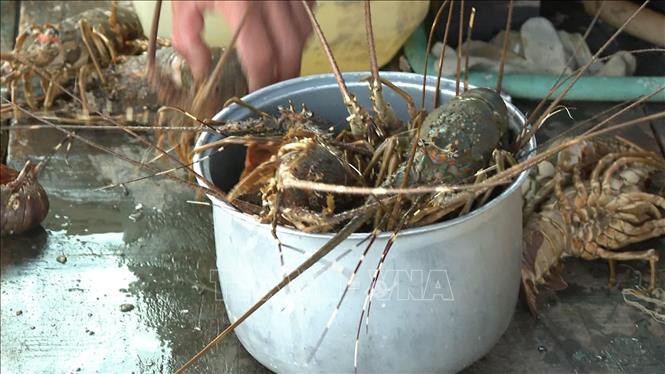
Shrimp have been dying due to disease. Photo: TTXVN
Earlier, in mid-April, the Khanh Hoa Department of Agriculture and Rural Development, in collaboration with the Institute of Aquaculture III and the People’s Committee of Van Ninh District, dispatched a survey team to the lobster farming areas in Van Phong Bay, including Van Thanh and Van Hung communes, to evaluate the cause of death in lobsters.
The team measured the basic parameters at the site and collected 4 water samples, 1 sediment sample, and 4 diseased lobsters for analysis at the laboratory of Institute III.
Results showed that at the two sampling points, dissolved oxygen levels were below the acceptable limit at the bottom, and the density of Vibrio spp. exceeded the limit by 1.8-3.3 times. The water temperature at the lobster cage in Xuan Vinh Hamlet was high (31.1 degrees Celsius). The collected water samples had relatively high levels of H2S.
Lobster samples collected in both survey areas tested negative for parasites and the agent that causes milky disease (Rickettsia-like bacteria). However, 100% of lobster samples from Mui Nai, Van Thanh Commune, had been infected by Fusarium sp. fungus. In addition, Vibrio alginolyticus bacteria were found in high concentrations in samples of lobsters from both survey areas.
Based on these results, Institute III has observed that water temperatures in the survey areas have been higher than in the same period in 2023. These high temperatures increase the risk of pathogens developing and affecting lobsters. The institute has identified the pathogen that causes black gill disease in the gills of slipper lobsters (Fusarium sp. fungus) in samples collected at Mui Nai, Van Thanh Commune. This could be the primary cause of respiratory distress in slipper lobsters, leading to oxygen deprivation and sporadic deaths in the Mui Nai farming area.
In addition, high levels of Vibrio bacteria in the lobster samples, water samples, and sediment from the survey area, particularly V. alginolyticus detected in high concentrations in lobster samples, may be secondary factors contributing to the sporadic lobster deaths.
Low dissolved oxygen levels in the water at the bottom, elevated water temperatures compared to the same period last year, high stocking densities, and seasonal weather changes have contributed to reduced lobster immunity, making them weaker and more susceptible to disease.
In view of this situation, the Institute of Aquaculture III has advised farmers to provide shade for cages and rafts during hot weather and to collect mollusk shells during and after feeding to minimize anaerobic processes on the bottom and sediment build-up at the bottom of the farming area.
Farmers should also reduce stocking densities to minimize losses, increase underwater monitoring of lobsters, and use formalin at a concentration of 300 ppm for 20-minute baths three times over seven consecutive days to treat lobsters with weak feeding and black gills.
Additionally, farmers can use the technical solution recommended by the competent authorities to treat red body disease in lobsters showing signs of red coloration in the area. Cages and rafts that have been emptied should be lifted above the water surface, and the distance between cages and rafts should be increased (if possible) to ensure good water circulation. Farmers should avoid placing lobster cages in shallow waters less than 8 meters deep, especially in the farming area of Xuan Vinh Hamlet, Van Thanh Commune. It is also advisable to avoid introducing new stock at this time.












